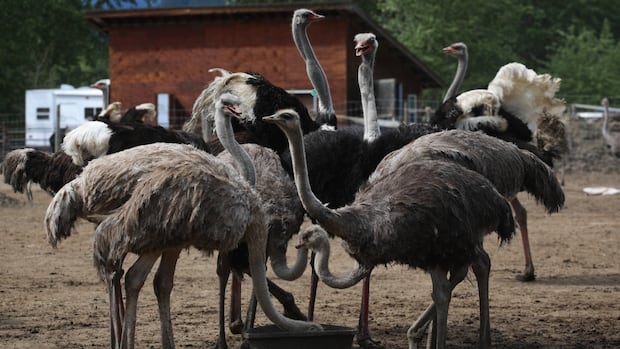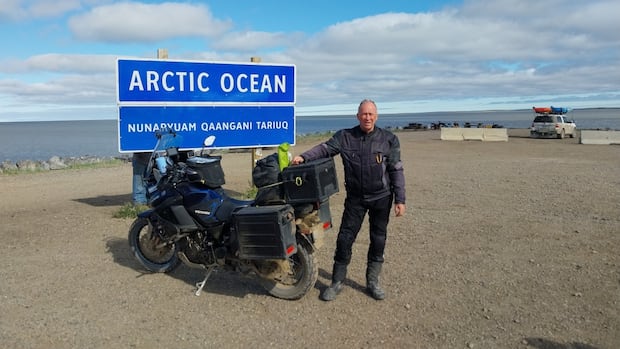THE LATEST
- Evacuation orders are in place in areas near Kelly Lake, B.C., due to the Kiskatinaw River fire and along the Alaska Highway due to the Summit Lake fire.
- A stretch of Alaska Highway will be closed at 5 p.m. PT Friday and is expected to remain closed throughout the night.
- The Kiskatinaw River fire has moved into Alberta as of Thursday evening.
- Wildfires of note are expected to grow due to elevated winds.
The B.C. Wildfire Service is expecting an intense weekend of fire activity as winds threaten to fan the flames of two major wildfires in the province’s northeast.
The two fires, the Kiskatinaw River fire and the Summit Lake fire, are marked as “wildfires of note,” meaning they pose a risk to human life or critical infrastructure.
The Kiskatinaw River fire, near the community of Kelly Lake, B.C., nearly 60 kilometres southeast of Dawson Creek, is currently estimated at 119 square kilometres, but fire information officer Karley Desrosiers said that number is likely an undercount based on the growth seen Thursday evening.
“We’re certainly in for a couple more very challenging days,” said Desrosiers, adding the situation will likely be “very volatile and dynamic” between now and Sunday.
At a news conference on Friday, Desrosiers said there is the potential for the fire to grow significantly.
The perimeter of the fire has not reached the Kelly Lake boundary, though Desrosiers said embers that were swept ahead of the flame front into the community caused spot fires.
She noted a wind shift expected around 5 p.m. on Friday could push a flank of the fire toward the Kelly Lake community.
The Peace River Regional District has issued evacuation orders within the Kelly Lake area.
The last known number of properties in the area was 56, but the district’s emergency operations centre director, Ryan Kirkham, said the number has grown since the last census in 2021.
Desrosiers noted the fire crossed over the Alberta border north of Kelly Lake Thursday evening.
The B.C. Wildfire Service has multiple helicopters doing “bucketing,” pouring water over areas to cool them down, and performing high-level scans to map the perimeter.
The County of Grande Prairie and Alberta Wildfire are also supporting the B.C. Wildfire Service and the organizations are working from the same facility in Dawson Creek.
“They are providing resource support both from a decision-making perspective and capacity, and also resources on the ground as those are available to them.”
Officials said they had no reports of affected infrastructure.
Desrosiers couldn’t say when the orders might be rescinded.
“Until we make it through that period of very strong, very erratic and, quite frankly, very, very dangerous conditions, we will be in no position to reassess the evacuation orders or alerts.”
She thanked the community for its support of the crews on the ground.
“They are doing everything they can to protect life and property. That is their No. 1 priority.”
Summit Lake wildfire grows
B.C.’s second wildfire of note, the Summit Lake wildfire along the Alaska Highway west of Fort Nelson, B.C., has tripled in size to 83.54 square kilometres from 26 square kilometres on Thursday.
The Northern Rockies Regional Municipality has issued an evacuation order for an area along the Alaska Highway corridor from the Summit Lake Campground to the Steamboat Mountain brake check.
The Fort Nelson First Nation issued an evacuation order on Friday night for Kahntah IR #3 area, an area 100 kilometres southeast of the community of Fort Nelson First Nation and 108 kilometres northeast of the community of Prophet River.
The B.C. Wildfire Service has told drivers to expect delays on Highway 97 (Alaska Highway).
Public Services and Procurement Canada said the Alaska Highway will be closed at the Highway 77 junction and Toad River to traffic at 5 p.m. PT Friday as strong winds are affecting the fire’s behaviour. The department said it expects the road will remain closed throughout the night. An update is expected at 8 a.m. PT Saturday.
Information officer Madison Dahl told CBC News the growth is, in part, due to a nine-square-kilometre aerial ignition completed on June 3.
“The purpose of these aerial ignition operations was to reduce the intensity of the fire behaviour along this section of Highway 97 by removing unburnt fuel to prevent it from free burning under more challenging weather conditions,” the wildfire service said in its latest update.
Dahl said the Summit Lake wildfire is expected to grow as elevated winds influence fire behaviour and noted conditions may change quickly.
“The fire is burning in incredibly rugged and difficult terrain with very limited natural barriers or breaks in fuel continuity,” the service said in the update.
There are 69 active wildfires in the province, 41 of which are classified as “out of control.”






